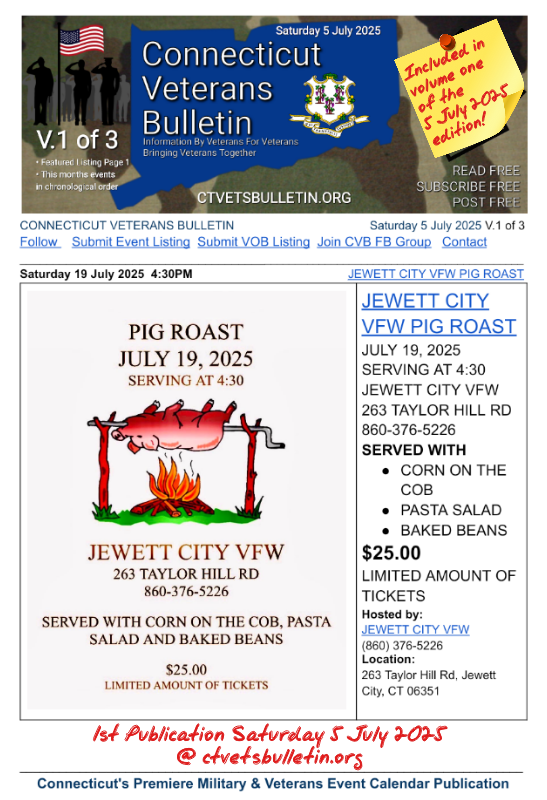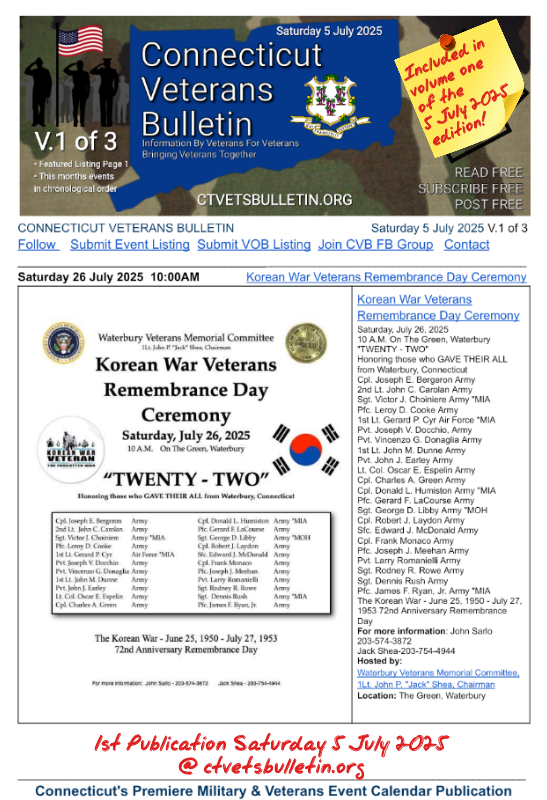In this week’s Thursday Preview, we spotlight the latest additions to our Veterans Calendar for the upcoming Saturday, 5 July 2025. These events and programs are thoughtfully curated to support and engage Connecticut’s veteran community.
For a complete list of events and more details, please refer to the full Connecticut Veterans Calendar in our upcoming publication or though our previous publication doesn’t include the events here, it has the all others.
This Thursday Preview highlights new Connecticut Veterans events added to the upcoming Saturday Calendar. Each listing has its own dedicated PDF flyer for easy viewing, sharing, or printing. All events are located in Connecticut and are curated specifically for Veterans, service members, and their families.
Thursday 3 July 2025 5:00 AM
Included in the Connecticut Veterans Calendar on ctvetsbulletin.org for Saturday, 5 July, 2025
Events are in order by date
SONS OF THE AMERICAN LEGION KARAOKE Nights

SONS OF THE AMERICAN LEGION KARAOKE Nights
KARAOKE IS BACK!!
JULY 5TH, JULY 19TH, AUGUST2ND, AUGUST 16TH, AUGUST 30TH 8PM
SAL TO HOST IN OUR CANTEEN OPEN TO THE PUBLIC ALL WELCOME
COME SING, HAVE A DRINK, PLAY SONE POOL. ALWAYS A GOOD TIME!
SPECIAL THANKS TO DIANA & ED
Hosted by: AMERICAN LEGION CANTEEN POST 68 (860) 828-9102
Location: 154 PORTERS PASS BERLIN CT 06037
Motorcycle Show At Port 5

Motorcycle Show At Port 5
JULY 6TH – 12Ν το 4P
69 BREWSTER ST, BRIDGEPORT
$25.00 PER BIKE
TROPHIES FOR
- BEST IN SHOW
- BEST PAINT
- MOST OUTRAGEOUS
50/50 RAFFLE – CORNHOLE – DJ – GALLEY IS OPEN
Sponsored By Haymond Law Firm
Hosted by:
Port 5 National Association of Naval Veterans
(203) 576-9366
Location: 69 Brewster St,
Bridgeport, CT 06605
FLY, YVN, & DAY Summer Social

FLY, YVN, & DAY Summer Social
Wednesday, July 9 | 5-7 PM | RSVP: https://cglink.me/2dA/r2299208
Get ready to kick off summer in style at our first social of the new fiscal year! The Future Leaders of Yale (FLY), Yale Veterans Network (YVN), and Disability Alliance at Yale (DAY) are teaming up to bring you an evening of connection, laughter, and celebration.
Join us for great food at Bear’s BBQ, upbeat vibes, and a chance to unwind with colleagues and friends across campus. There will be exciting door prizes, fun trivia, and plenty of opportunities to network in a relaxed, festive atmosphere.
Don’t miss this chance to make new connections, share some laughs, and launch your summer with a burst of energy!
Hosted by by:
The Future Leaders of Yale (FLY), Yale Veterans Network (YVN), and Disability Alliance at Yale (DAY)
Location:
470 James St,
New Haven, CT 06513
Port 5 HOEDOWN

Port 5 HOEDOWN
Saturday 12 July 2025 3:00PM
🇺🇸⚓️Put your cowboy boots on and eat, drink and listen to some great country western music!! YOU CAN BUY TICKETS ONLINE ON OUR WEBSITE!! 🇺🇸⚓️
Click this link https://www.portfiveusa.com/event-details/port-5-hoedown to register and pay by credit card to reserve your spot now before we sell out.
Hosted by: Port 5 National Association of Naval Veterans (203) 576-9366
Location: 69 Brewster St, Bridgeport, CT 06605
JEWETT CITY VFW PIG ROAST

JEWETT CITY VFW PIG ROAST
JULY 19, 2025
SERVING AT 4:30
JEWETT CITY VFW
263 TAYLOR HILL RD
860-376-5226
SERVED WITH
- CORN ON THE COB
- PASTA SALAD
- BAKED BEANS
$25.00
LIMITED AMOUNT OF TICKETS
Hosted by:
(860) 376-5226
Location:
263 Taylor Hill Rd, Jewett City, CT 06351
Korean War Veterans Remembrance Day Ceremony

Korean War Veterans Remembrance Day Ceremony
Saturday, July 26, 2025
10 A.M. On The Green, Waterbury
“TWENTY – TWO”
Honoring those who GAVE THEIR ALL from Waterbury, Connecticut
Cpl. Joseph E. Bergeron Army
2nd Lt. John C. Carolan Army
Sgt. Victor J. Choiniere Army “MIA
Pfc. Leroy D. Cooke Army
1st Lt. Gerard P. Cyr Air Force *ΜΙΑ
Pvt. Joseph V. Docchio, Army
Pvt. Vincenzo G. Donaglia Army
1st Lt. John M. Dunne Army
Pvt. John J. Earley Army
Lt. Col. Oscar E. Espelin Army
Cpl. Charles A. Green Army
Cpl. Donald L. Humiston Army “MIA
Pfc. Gerard F. LaCourse Army
Sgt. George D. Libby Army “MOH
Cpl. Robert J. Laydon Army
Sfc. Edward J. McDonald Army
Cpl. Frank Monaco Army
Pfc. Joseph J. Meehan Army
Pvt. Larry Romanielli Army
Sgt. Rodney R. Rowe Army
Sgt. Dennis Rush Army
Pfc. James F. Ryan, Jr. Army “MIA
The Korean War – June 25, 1950 – July 27, 1953 72nd Anniversary Remembrance Day
For more information: John Sarlo 203-574-3872
Jack Shea-203-754-4944
Hosted by:
Waterbury Veterans Memorial Committee, 1Lt. John P. “Jack” Shea, Chairman
Location: The Green, Waterbury
Baseball Night With Guardians of the Purple Heart

Baseball Night With Guardians of the Purple Heart
SATURDAY 2 AUGUST
GAME STARTS AT 6:30PM
Norwich Sea Unicorns
PRESENT
BASEBALL Night
TICKETS $10
WITH
NORWICH SEA UNICORNS
VS
WORCESTER.
Bravehearts
DODD STADIUM
14 Stott Ave Norwich, CT 06360
Presented by:
(860) 887-7962
Location: Senator Thomas J Dodd Memorial Stadium
14 Stott Ave,
Norwich, CT 06360
VFW Post 149 Kid’s BINGO 9 August 2025

VFW Post 149 Kid’s BINGO
August 9th. 2025
Come join us for a fun time, Doors open at 10 am & Bingo starts at 11am. Cost is $10.00, this will give you all the games, a dauber (to mark your cards), & food.
Your choice of Hot Dogs, Mac & Cheese, Chicken Nuggets. Chips, juice or water (NO SODA)
Just remember that an adult must be with the kids, they can play bingo as well but all the winnings go to the kids.
Hosted by:
(203) 748-9579
Location: 5 Byron St, Danbury, CT 06810
Warren 2nd Annual Car & Truck Show

Warren 2nd Annual Car & Truck Show
AUG 16th Rain date TBD
10 AM to 1 PM
$20.00 entry
10 Rings, trophies, food & music
Hosted by WARREN RTC with a portion of proceeds going to AMERICAN LEGION POST 27, Litchfield
Free to spectators
All makes, models & years welcome
Club parking available -reserve in advance
Media sponser: CT Cruise News
“GET YOUR RING ON!
Call Scott Perssonatti 860-459-4170
Paid for by the Warren Republican Town Committee C. Frisbie. Treasurer
Hosted by by:
(860) 584-9119
Location:
Warren Woods
251 Brick School RD
Warren, CT 06754
Morgan Weir Post 27 3RD Annual BBQ Clambake

Morgan Weir Post 27 3RD Annual BBQ Clambake
AUGUST 16
2:30-7:30
$60
- PIG ROAST
- CHICKEN
- STEAMERS
- RAW CLAMS
- BURGERS
- HOT DOGS
- SIDES
- DESSERTS
JEFF SUMMA AND THE ROASTERS 3-6:30 PM*
Tickets: Call or Stop By 860-567-9930
RAIN DATE 8/17
CASH BAR-NO BYOB
Hosted by:
Sons of the American Legion Squadron 27
Location: THE AMERICAN LEGION, 418 Bantam Road, Litchfield, CT
Art Ward Memorial Golf Tournament 2025

American Legion Post 2
Art Ward Memorial Golf Tournament 2025
Sunday, August 17, 2025
8:00a.m. Check-in
9:00 a.m. Shotgun Start
Hawk’s Landing Country Club Southington, CT $150
per golfer
Lunch on course Dinner and raffle following at American Legion Post 2, 22 Hooker Court Bristol, CT
Contests, Win a Jeep, Hole-in-One Challenge, Games and Gifts for Golfers! Limited to 128 golfers. First come, first served
Sponsorship Opportunities Available. Proceeds Benefit the Baseball Program, Post 2, and Scholarships
Spec Monico (860) 712-1662
Dave Connelly (860) 205-2561
Hosted by by:
(860) 589-0088
Location:
201 Pattonwood Dr, Southington, CT 06489
22 Hooker Ct,
Bristol, CT 06010
Surfside Veterans Car Show Fundraiser

Surfside Veterans Car Show Fundraiser
AUGUST 30, 2025
12noon – 6pm
Admission Fee $20 Per Car
West Haven City Hall Community Parking Lot
Trophies
Certificate of Appreciation
Light Refreshments
To register contact – Richard – 860-710-1833
Hosted by:
(860) 710-1833
Location:
West Haven City Hall Community Parking Lot. behind City Hall, off Savin Avenue
10th Annual Connecticut Veterans Day Race

10th Annual Connecticut Veterans Day Race
🇺🇸 Run. Walk. Ruck. Honor. 🇺🇸
Join us Nov 8, 2025 at Patriots Park, Coventry, CT for the 10th Annual CT Veterans Day Race!
4-Mile Run | 3-Mile Walk | 3-Mile Ruck
Live & virtual options available!
100% of proceeds go to CT veteran service organizations.
Ruck with purpose—bring items for veterans in need.
Patriotic vibes, amazing community, and a powerful cause!
Register or learn more: https://runsignup.com/Race/Register/?raceId=103701
#CTVeteransDayRace #HonorOurHeroes #CoventryCT #VeteransDay #Patriotspark #Run #Walk #Ruck #Veterans
Hosted by:
(860) 478-6802
Location:
Coventry Connecticut
